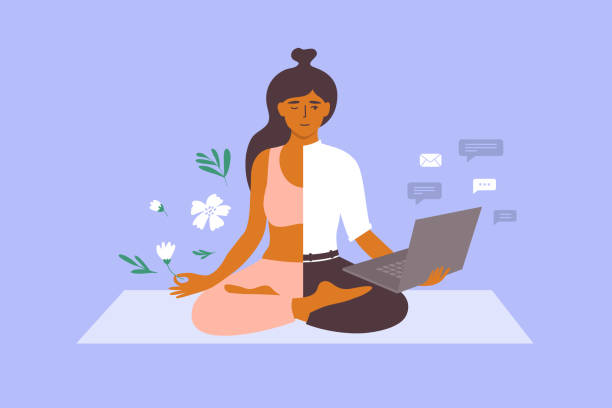In today’s fast-paced world, many people struggle with stress, whether it stems from work, personal responsibilities, or the constant demands of daily life. While we often associate stress with mental and physical health issues such as anxiety, fatigue, and tension, its effects on eye health are less commonly discussed. However, research suggests that stress can contribute to or worsen certain eye conditions, including eye strain, dry eyes, and even fluctuations in vision. Persistent stress may also lead to increased eye pressure, which can be a concern for those at risk of conditions like glaucoma.
The good news is that incorporating relaxation techniques, such as meditation, deep breathing, and mindfulness, can help reduce stress levels and support overall eye health. These practices encourage relaxation, improve circulation, and ease muscle tension around the eyes, leading to better comfort and visual well-being. In this post, we’ll explore how meditation and stress reduction techniques can not only benefit your eyes but also enhance your overall sense of well-being, helping you feel more relaxed, focused, and refreshed.
What Happens to Your Eyes When You’re Stressed?
Stress triggers a complex chain of physiological reactions in your body, preparing it to respond to perceived threats. When you’re stressed, your body enters “fight or flight” mode, releasing stress hormones like cortisol and adrenaline. This leads to an increase in heart rate, elevated blood pressure, and muscle tension as your body prepares to react quickly. While this response is useful in short bursts, chronic stress can take a toll on your overall health.
Beyond affecting your mood and energy levels, stress can also impact your vision and eye health. The tension in your muscles may extend to the tiny muscles around your eyes, leading to discomfort, strain, and even headaches. Prolonged stress can contribute to dry eyes, blurry vision, and light sensitivity, as well as increase intraocular pressure, which may be concerning for individuals at risk for conditions like glaucoma. Managing stress effectively through relaxation techniques, mindfulness, and proper self-care can help reduce its impact on your eyes and overall well-being.
- Eye strain and fatigue: Staring at a screen for too long is bad for your eyes, but when you’re stressed, you might be more prone to it. The extra mental tension can make your eyes feel tired, dry, or sore.
- Increased pressure: Chronic stress may contribute to increased eye pressure, which can lead to conditions like glaucoma. Glaucoma is an eye disease that damages the optic nerve, often caused by high pressure in the eye.
- Vision problems: Stress can even cause blurry vision or make existing vision issues worse. The body’s reaction to stress might affect the muscles around the eyes, making it hard to focus clearly.
How Meditation and Stress Reduction Help Eye Health

Meditation, a practice that encourages mindfulness and relaxation, can help reduce the harmful effects of stress on your body. By calming your mind, you can improve your overall health and protect your eyes. Here’s how:
1. Lowering Blood Pressure and Eye Pressure
One of the ways meditation helps eye health is by reducing blood pressure. High blood pressure can increase the risk of eye conditions like diabetic retinopathy and hypertensive retinopathy, both of which can cause vision loss. Meditation helps to activate the parasympathetic nervous system, which lowers heart rate and relaxes blood vessels, helping to maintain healthy blood pressure levels.
Lowering blood pressure also impacts eye pressure. Since high eye pressure is a risk factor for glaucoma, reducing stress through meditation may help protect the eyes from this serious condition.
2. Relaxing the Eye Muscles
Stress causes muscles in the body to tighten, including those around the eyes. This can lead to tension headaches and discomfort. Regular meditation helps your muscles relax, including the ones around the eyes. Meditation techniques that focus on deep breathing or progressive muscle relaxation help ease muscle tension, which can reduce eye strain and fatigue.
In addition, taking time to rest your eyes by practicing mindfulness can prevent strain caused by too much screen time. Focusing on your breath during meditation can also help you become more aware of your body’s tension and release it, improving your eye health in the process.
3. Reducing the Risk of Eye Diseases
Chronic stress can lead to several eye diseases, such as glaucoma or macular degeneration. By practicing mindfulness and relaxation, meditation can help lower your risk of developing these diseases. Research has shown that meditation can reduce cortisol levels in the body, which is a hormone associated with stress. By lowering stress, you reduce your risk of conditions that could harm your eyes.
Not only eye health but meditation also promotes general health, which indirectly benefits the eyes. For example, by lowering inflammation in the body, meditation may reduce the risk of inflammation-related eye conditions, such as uveitis, which causes swelling in the middle layer of the eye.
4. Improving Focus and Visual Clarity
Stress can blur your vision, making it harder to concentrate. But regular meditation can improve your focus and clarity, not just mentally but also physically. Mindfulness meditation, in particular, helps improve concentration and attention, making it easier to focus on your environment without feeling overwhelmed. By calming your mind, you may also notice an improvement in your ability to focus on objects, reducing the likelihood of blurry vision caused by stress.
Types of Meditation for Eye Health
There are several types of meditation that can help reduce stress and improve your eye health. Here are some practices you can try:
1. Mindfulness Meditation
Mindfulness meditation involves focusing on the present moment, often by directing your attention to your breath. This practice encourages a state of awareness that helps quiet the mind and reduce stress by keeping you grounded in the here and now. As you concentrate on your breathing, you may notice a sense of calm spreading throughout your body, easing physical and mental tension.
This relaxation extends to the muscles around your eyes, which can become strained due to prolonged screen time, stress, or fatigue. By practicing mindfulness regularly, you can promote overall well-being while giving your eyes a much-needed break.
2. Breathing Exercises

Deep breathing exercises, such as diaphragmatic breathing, can activate the body’s relaxation response, promoting a sense of calm and well-being. By taking slow, deep breaths, you engage the diaphragm fully, allowing more oxygen to reach your bloodstream and helping to regulate your heart rate. This process soothes the nervous system, reducing stress and tension throughout the body.
As stress levels decrease, blood circulation improves, ensuring that essential nutrients and oxygen are delivered more efficiently to various organs, including the eyes. Better circulation can help reduce eye strain, dryness, and fatigue, ultimately supporting overall eye health and visual comfort.
3. Progressive Muscle Relaxation
Progressive muscle relaxation (PMR) is a technique that involves systematically tensing and then relaxing different muscle groups in your body, including those around your eyes. This method helps increase awareness of physical tension and teaches you how to consciously release it.
When you focus on relaxing the tiny muscles around your eyes, forehead, and temples, you can relieve built-up strain caused by stress, prolonged screen use, or eye fatigue. Practicing PMR regularly not only helps ease tension in the eyes but also promotes full-body relaxation, reduces stress levels, and enhances your overall sense of well-being. Over time, this technique can contribute to improved focus, comfort, and even better sleep quality.
4. Visualization
Visualization is a powerful meditation technique where you create mental images of peaceful, calming scenes or scenarios to promote relaxation. By picturing a serene place—such as a quiet beach, a lush forest, or a tranquil garden—you can engage your senses and immerse yourself in a soothing experience.
This practice helps shift your focus away from daily stressors, allowing your mind and body to relax. As stress levels decrease, your heart rate slows, and your nervous system enters a more restful state. Additionally, visualization can help reduce eye strain by encouraging you to take a break from screen exposure and mental fatigue.
Some studies suggest that relaxation techniques like visualization may even contribute to lowering intraocular pressure, which can be beneficial for overall eye health. Practicing visualization regularly can enhance mindfulness, promote emotional balance, and provide a refreshing mental escape from the demands of daily life.
How to Incorporate Meditation into Your Daily Routine

You don’t need to spend hours meditating to see benefits for your eye health. Even a few minutes a day can make a difference. Here are some tips to incorporate meditation into your routine:
- Start small: Begin with just 5–10 minutes a day. Focus on your breathing or try a simple mindfulness practice.
- Find a quiet space: Choose a comfortable spot where you won’t be disturbed. It could be your bedroom, a park, or even your office during a lunch break.
- Use apps: There are plenty of meditation apps that can guide you through different techniques. Apps like Headspace and Calm are great places to start if you’re new to meditation.
- Be consistent: Try to meditate at the same time each day to build a routine. It could be in the morning before you start your day or at night before bed.
Additional Tips for Eye Health
In addition to meditation, there are other steps you can take to improve and maintain healthy eyes:
- Get regular eye exams: Routine eye check-ups can help catch eye diseases early and prevent vision loss.
- Follow the 20-20-20 rule: If you spend long hours in front of a screen, take a break every 20 minutes to look at something 20 feet away for 20 seconds.
- Eat a healthy diet: Foods rich in vitamins A, C, and E, as well as omega-3 fatty acids, can support eye health.
- Exercise regularly: Physical activity increases blood flow to your eyes, helping them stay healthy.
Meditation and stress reduction techniques can play a key role in improving your eye health by promoting relaxation and overall well-being. Chronic stress and tension can lead to eye strain, dryness, and even increased intraocular pressure, which may contribute to certain eye conditions over time. By practicing meditation, deep breathing, or mindfulness, you can activate your body’s relaxation response, helping to lower stress hormones, improve blood circulation, and ease muscle tension around the eyes.
Additionally, meditation encourages you to take intentional breaks from screens and other visually demanding tasks, allowing your eyes to rest and recover. Research suggests that relaxation techniques may also help reduce the risk of stress-related eye diseases, such as glaucoma and digital eye strain. With its natural and holistic approach to better vision, meditation provides a simple yet powerful way to care for your eyes. So, the next time you feel overwhelmed or fatigued, take a few moments to close your eyes, breathe deeply, and meditate—your eyes and your mind will thank you.

